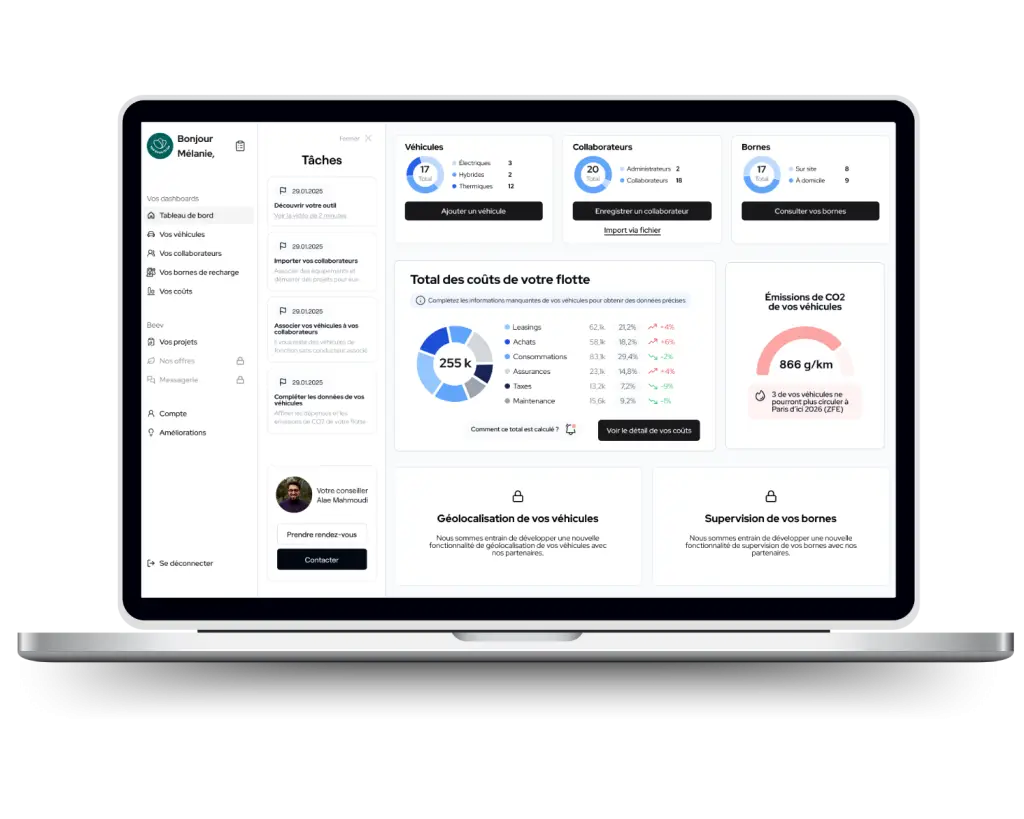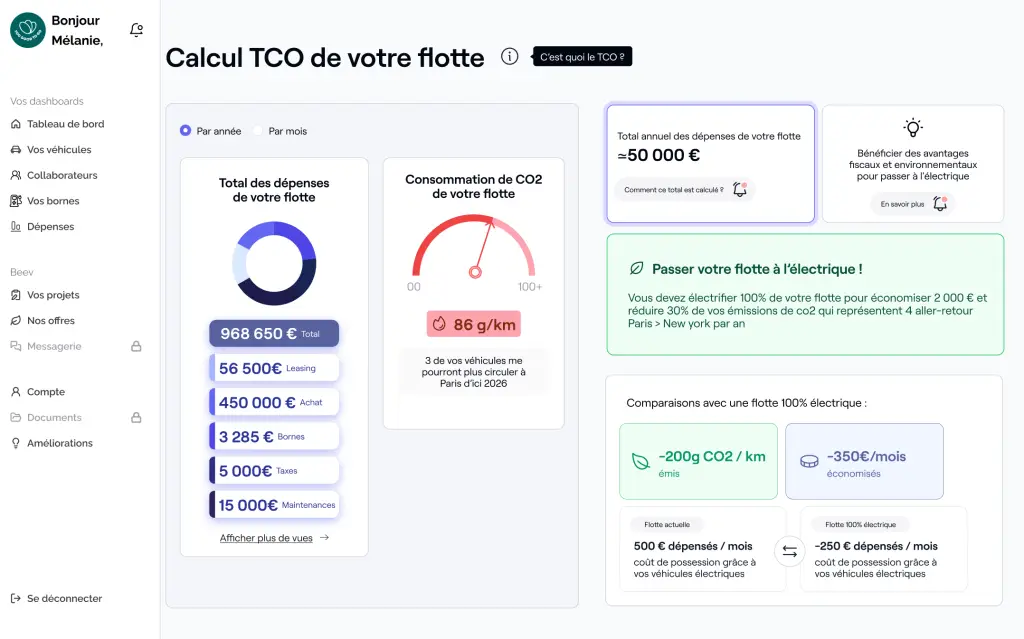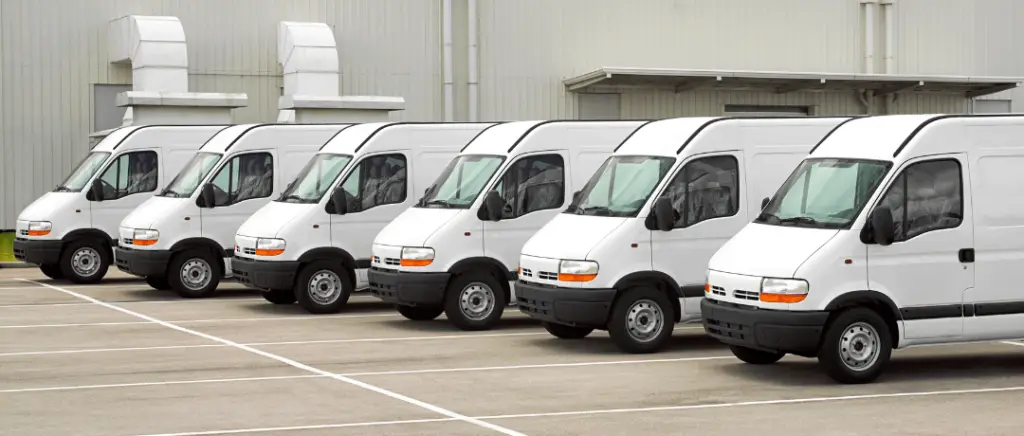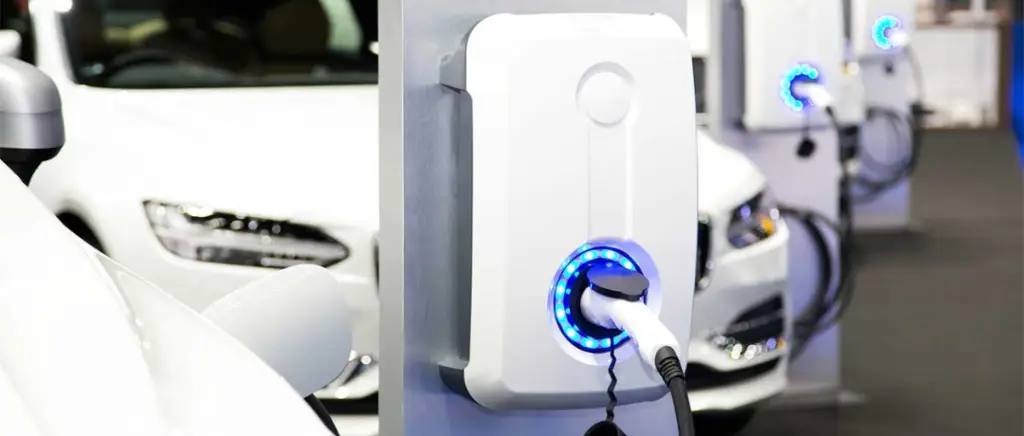Home > Electrify your fleet with Beev > Fleet management software: tools compatible with the electric transition
Fleet management software: tools compatible with the electric transition
The energy transition is no longer an abstract concept or the preserve of major cities: it is now part of the day-to-day operations of thousands of fleet managers across France. With a increasingly stringent regulations on CO₂ emissionsfleet managers and logistics managers no longer have a choice: adapting their management to the electric shift is no longer an option, but a necessity.
But electrifying a fleet cannot be improvised. Switching to an electric vehicle raises a number of new issues autonomy, recharging planning, power management, etc. total cost of ownership (TCO)integration of charging stationsand monitoring environmental performance. In this context fleet management software is becoming an essential ally in managing this transition with efficiency and agility.
But you need to choose the right tool. Not all software is (yet) suited to electric mobility. Some struggle to integrate data from kiosks, while others offer no TCO simulation or a clear view of the environmental benefits.
In this article, we explore the main fleet management software compatible with the electric transitiontheir functionalities keys and criteria to make the right choice in a demanding professional context.
Table of contents
Why is the electric transition redefining fleet management?
Change driven by regulatory requirements
From 1 January 2024, the legislative framework has been considerably strengthenedUnder the LOM law, any company with a fleet of more than 100 vehicles must now include at least 20% of low-emission vehicles (i.e. electric cars or rechargeable hybrids) in its fleet renewals. This quota will rise to 40% from 2027, then to 70% in 2030This will speed up the pace of the transition for all the companies concerned.
In addition, professionals who do not comply with these thresholds are exposed to significant financial penalties, with fines of up to €5,000 per missing vehicle in line with the latest legislative developments.
See also our article :
In addition to the number of vehicles, other obligations directly concern charging stations companies must equip a an increasing proportion of their car parks have charging points (minimum 5%, soon to be increased to 10%).
See also our article :
All of these constraints are in addition to the requirement for companies with more than 50 employees to draw up a Mobility Plan including measures to reduce the carbon footprint.
See also our article :
This regulatory change is also accompanied by a tax upheaval: phasing out of certain benefits for hybrid vehicles, introduction of new annual tax incentives to accelerate greening, and adjustment of the calculation of fringe benefits for electric company cars. In other words, fleet managers are being forced to review their purchasing, allocation and cost management policies in depth.
See also our article :
Growing economic and environmental challenges
The economic dimension has become essential for fleet managers. In use, the electric vehicles show a total cost of ownership (TCO) generally lower than that of internal combustion vehiclesThis is thanks to lower fuel, maintenance and specific tax costs. For example, companies benefit from savings on maintenance, as a electric vehicles have fewer wearing parts and require less mechanical intervention. In addition, theelectricityespecially when consumed during off-peak hours, thanks to intelligent recharging solutions, remains a key factor for energy efficiency. more advantageous than conventional fuels.
Accompanying measures, such as the professional leasing flexible hoses or Fleet-as-a-Service (FaaS) offersThis allows the initial investment to be smoothed out and the integration of electric vehicles to be tested without tying up too much capital, thereby adapting to economic uncertainty.
In addition, the telematic equipment and theuse of real-time data make it easier to optimise journeys, reducing unnecessary mileage and rationalising energy consumption.
In addition to the regulatory issues mentioned above, the controlling our carbon footprint has become a key CSR assetCO₂ emissions reporting and compliance with the new ESG standards directly influence access to public contracts, financing and a company's reputation.
In turn, an electrified fleet is fully in line with the company's overall decarbonisation strategy and meets the growing demand from customers, talents and partners.
💡Did you know ? 64% of consumers say they prefer suppliers who have gone electric.
To deal with the complexity of this transition, fleet managers now need to rely on software with advanced functions :
- TCO calculator,
- regulatory alerts,
- energy optimisation,
- real-time emissions monitoring,
- and predictive management tools using artificial intelligence.
These tools make it possible toexploiting the full potential of electromobility to transform fleet management into a global performance driver: more agile, greener and more profitable than ever.
New requirements for managing an electric fleet
Specific operational constraints
For fleet managers and logistics managers, the transition to an electric fleet radically transforms day-to-day management and introduces new operational challenges, very different from those encountered with a combustion-powered fleet.
Optimising recharge management: a strategic imperative
The question of recharging is becoming central. Unlike a quick refuelling, recharging an electric vehicle requires a considerable amount of time. significant downtimeoften lasting several hours. The organisation of schedules must therefore take account of these charging times without penalising productivity. The right management tools can be used to schedule recharging during off-peak hours, which can reduce electricity bills by 15 to 20%.
In addition, approximately 80% of fleet top-ups are done at the depot It is therefore essential to invest in suitable on-site terminals and, for mobile employees, to equip their homes or negotiate access to public networks.
Monitoring and anticipating autonomy: the end of the "fear of breakdown".
The management of an electric fleet relies on software solutions capable of monitoring the state of charge and range of each vehicle in real time. The manager must therefore be able to :
- anticipate the risks of breakdown,
- identify immediate refuelling needs,
- view the entire fleet on a map,
- and receive proactive alerts in the event of an anomaly (interrupted charge cycle, low battery, etc.).
Adapting operations to specific electrical requirements
L'mission profile analysis (short/long journeys, urbanity, frequency, seasonality) becomes essential for selecting the right vehicles and sizing the infrastructure. For example, a a company making multiple deliveries within a 50 km radius will not have the same expectations as a sales team covering large regions. The wrong choice of autonomy can have a severe impact on your business.
Maintenance, supervision and proactive management
While electric vehicles require less mechanical maintenanceAs a result, the supervision of chargepoints and the maintenance of infrastructures are becoming critical. Companies need to set up high-performance supervision systems to guarantee the continuous availability of chargepoints and to react quickly in the event of a fault. This preventive approach can reduce vehicle downtime by up to 30%.
Energy reporting and TCO control
Digitalising fleet management means you can measure energy efficiency on a vehicle-by-vehicle basis, d'optimise operating costs and prove the profitability of the transition. This makes it possible to compare electricity consumption with that of a fossil-fuelled fleet, identify the savings made and ensure that environmental targets are met.
The strategic role of data in the energy transition
That's right, more than just a monitoring toolData can be used to develop fine-tuned, optimised and predictive management, which is essential for the specific characteristics of electric vehicles.
Manage your fleet easily with our dedicated tool

A fleet management tool from A to Z
- Add your fleet and employees in just a few clicks
- Plan your transition to electric vehicles and monitor your CSR objectives in real time
- Centralise your expenses

Real-time data collection and analysis for an accurate global view
Modernised fleet management software incorporates sensors and telematic systems which continuously collect :
- remaining range,
- recharging sessions,
- energy consumption,
- information on the state of charge,
- but also the conditions of use: type of journeys, driving style, and even environmental factors (weather, terrain).
This 360° visibility offers managers the ability toanticipating recharging needs andavoid impulsive interruptionsThis reduces the risk of breakdowns and downtime.
Managing the energy transition with a data-driven strategy
Analysis of the data enables us to precisely size the electric fleet. By cross-referencing daily mileage, mission profiles (urban, long-distance) and actual consumption, the managers can better select suitable vehicles and plan the installation of recharging infrastructure.
Cost optimisation and energy efficiency measures
Data-driven tools offer a close monitoring of total cost of ownership (TCO), comparing the electricity and fuel consumption of plug-in hybrid vehicles, as well as data associated with charging stations. This energy reporting to justify investments to finance departments and optimise energy bills. It also reinforces the CSR approach by providing quantified proof of the environmental gains achieved.
Take agile operational decisions and adjust strategy with agility
The data collected facilitate ongoing adaptation of the management strategy. For example, managers can identify anomalies in charging cycles and receive alerts in real time, anticipate congestion points on the infrastructure or adjust driver schedules according to vehicle availability. This flexible, responsive management transforms constraints into opportunities for continuous improvement.
Comparison: which 3 software packages are compatible with the electricity transition?
Beev Fleet Manager: eco-responsible global management
Designed specifically to meet the contemporary needs of fleet managers, the Fleet Manager from Beev stands out for its resolutely eco-responsible and pragmatic approach. This all-in-one software offers complete visibility of TCO of your fleet, allows you tooptimise your costs in real time and offers personalised support on the road to electrification.
Thanks to its intuitive dashboardsthe manager can see at a glance the total fleet expenditurethe level of CO₂ emissions or the energy consumption.

More than just a monitoring tool, Fleet Manager Beev offers advanced functionalities:
- Rapid fleet import for centralised management, without tedious re-keying.
- Integrated full audit to target areas for cost reduction and opportunities for electricity transition
- Optimised collaborative management These include the mass addition of drivers, individualised behaviour monitoring, automated vehicle allocation and recharging points (a feature currently in advanced development).
- CSR indicators in real timel: monitor the environmental impact of your fleet, track your emissions month by month, and align your actions with your company's CSR policies.
- Transition planning Decision-making tools to help you identify the right levers for migrating to electric vehicles and anticipate the next regulatory steps.


By relying on this Fleet Manager, many SMEs, ETIs and large groups are taking the electrification step with confidenceThey have also seen a reduction in management time and a significant improvement in their carbon footprint.
As the figures displayed on the interface show, the electric transition managed with Beev Fleet Manager allows you toaligning management performance with environmental challenges, without complexity or hidden extra costs.
It is now the benchmark tool in this field, appreciated for its user-friendliness and ROI-oriented approach.
But that's not all: one of Beev Fleet Manager's major assets is its ability to the clarity and flexibility of its pricing structure, suitable for all fleet sizes and levels of requirement. Unlike many competitors on the market, who impose complex packages or hidden charges, Beev offers a single, simple solution. transparent and progressive pricingaccessible from the first vehicle and scalable according to your electrification ambitions.
| Formula | Price (annual payment) | Number of vehicles included | Main functions |
|---|---|---|---|
| Free | Free | 0-3 | Economic fleet audit, vehicle import, simplified TCO |
| Pro | 49/month | 4-30 | All pack functions included + advanced audit, collaborative management |
| Fleet | 89/month | <50 vehicles | Advanced management, terminal supervision, detailed TCO, comprehensive analyses |
| Fleet+ | 169/month | <150 vehicles | Fleet functions + customised options, multi-fleet management, VIP support |
| Company | On request | >150 vehicles or multiple sites | Tailor-made offer, advanced integration, dedicated S.L.A. support. |
Worth noting : Beev offers reserved promotional offersThese include -50% for 3 months for new customers and a free fleet TCO audit (offer valid until September 2025).
Webfleet: optimisation and advanced reporting
Europe's first professional geolocation cloud softwareWebfleet has evolved to meet the new challenges posed by the electrification of fleets. Its objective is clear: to reduce costs, improve performance and support managers in the decarbonisation of their vehicle fleets.
Thanks to the real-time GPS geolocationWith Webfleet, you can find out where your vehicles are at all times, whether they are internal combustion or electric. This permanent monitoring is essential for :
- optimise routes,
- Reduce unnecessary mileage,
- allocate available vehicles more reactively.
In practice, this According to Webfleet, visibility could reduce fuel and maintenance costs by up to 20 %.This is an important lever for financing the transition to electric power.
In addition, Webfleet offers a detailed analysis of driving behaviour as well as customised reports on energy consumption CO₂ emissions and thevehicle wear and tear. This data is essential for :
- train drivers in electric eco-driving,
- identify the combustion vehicles to be replaced as a priority,
- select the most appropriate electric models according to actual use.
A concrete example? Thanks to thea tool for monitoring fuel consumption and emissionsThis means that managers can spot anomalies, quickly correct them and demonstrate the benefits of electrification to their management.
In other words, Webfleet does more than just provide data. It also offers a seamless integration with existing business toolsas well as a centralised management of interventions.
The result: a estimated return on investment between 6 and 9 monthseven for mixed fleets in transition.
GAC Car Fleet: compliance and TCO analysis
Compatible with all types of engines, including electric and hybrid vehicles. hybridsGAC Car Fleet helps companies to reduce their carbon footprint.
In particular, the software enables you to monitor CO₂ emissions from the entire fleet and measure the carbon footprint of vehicles.
GAC Car Fleet also includes a advanced TCO calculation module. But the tool goes even further by offering an exclusive Predictive TCOwhich allows you to estimate the cost of a vehicle before it is even ordered. This is particularly useful for guide motorisation choicesFor example, by comparing the overall cost of an internal combustion vehicle with that of an electric model.
Available in SaaS modeGAC Car Fleet is accessible from any connected device. It centralises all the essential data on the fleet (maintenance, claims, offences, taxation, etc.) and simplifies management, including for mixed fleets made up of combustion, hybrid or 100 % electric vehicles.
It should also be noted that theMyCarFleet mobile application is available for greater simplicity, on both the driver and driver's side.
💡 Good to know : The software is already connected to more than 250 suppliers (rental companies, insurers, oil companies, ANTAL, etc.), guaranteeing seamless data integration and significant time savings for the teams in charge of the fleet.
How do you choose the right electric fleet management software?
Before being seduced by marketing promises or an exhaustive list of features, take the time to carry out a tailor-made diagnosis of your fleet and your ambitions.
As a first step, start by identify the size of your fleet (number of vehicles, thermal/electric/hybrid mix) and plan your short- and medium-term development. Some software packages are suitable for small organisations, while others are more suited to large companies or multi-site management, such as the fleet manager Beev.
Also ask yourself about electrical specifications:
- Do you already have an electric 100% fleet or are you in the middle of a transition phase?
- Do you need accurate tracking of range, recharge cycles or CO₂ emissions?
- The best software includes energy monitoring, terminal management, TCO calculation and modules to manage the gradual conversion of the fleet.
Thirdly, draw up the list of priority functions:
- Automated preventive maintenance
- Real-time tracking of vehicles and terminals
- Energy and environmental reporting (CSR)
- Ability to integrate additional modules (e.g. fine tracking, car sharing, Business Intelligence).
- Integration of HR and accounting data (management of driver profiles, reimbursements, invoicing)
- Ergonomics and ease of use (intuitive interface, mobile accessibility for managers and users)
In addition, the solution must be compatible with :
- Your vehicle mix
- Existing recharging points
- Your existing tools (ERP, payroll, supplier management: integration simplifies management and reduces the risk of errors in invoicing or operational monitoring).
Finally, choose software that can grow with you. Choose :
- A scalable SaaS model with no hidden extras
- Business support (responsive customer support, educational resources, transition audit)
- Features that will enable you to go further in the energy transition over time.
Finally, set a realistic budget: some software is free for small fleetsOthers offer complete packages with CSR monitoring and advanced analyses. Bear in mind that good software must not only pay for itself in time saved and reduced TCObut also to help you achieve your CSR objectives.
Beev Council : Don't hesitate to test several tools via their trial versions, à involve your teams in the selection and draw up precise specifications.
Case study: Dstny's electrical transition a success with the help of Beev
The transition to a fleet of electric vehicles is not just a question of acquiring vehicles: it also involves digitising managementThis is the key to effectively managing the new technological, economic and environmental challenges. Testimonies from fleet managers confirm it: digitising means speeding up and securing the success of electrification.
Take the concrete example of Dstnya telecommunications company based in Clichy, which manages a fleet of 20 vehicles. As part of its drive to go electric, Dstny has chosen tointegrate a digital solution dedicated to managing their vehicles and optimising charging points. This choice played a decisive role in the success of the project.
A few figures illustrate Dstny's successful digitalization:
- 7 electric vehicles delivered and integrated into the fleet in just a few months.
- 100% of satisfaction reported by users of the internal service.
- 2 charging points installed and controlled via their digital management tool.
Beev's Fleet Manager tool has enabled :
- A centralised and automated monitoring of each vehicle and their electricity consumption,
- L'optimising the deployment of charging points according to users' real needs,
- L'immediate access to dashboards to convince management through full cost comparisons.
Dstny's feedback shows that the adoption of specialised digital tools is a major lever for overcoming the obstacles to the electric transition: it helps to simplify management, facilitate decision-making and involve all employees in the responsible mobility approach.
Conclusion: what the right software can do for your electric fleet
The transition to an electrified fleet is not simply a matter of renewing vehicles It is profoundly transforming the way in which logistics operations are managed, analysed and optimised on a day-to-day basis.
The choice of fleet management software compatible with electric mobility is therefore becoming a major strategic lever.
A the wrong tool can slow down your objectives, generate hidden additional costs or you incur penalties. Conversely, software designed for electromobility, capable of controlling TCO, anticipating energy requirements, centralising charging data and enhancing your CSR indicators, offers you a sustainable competitive advantage.
This is where Beev comes into its own. Thanks to a 100 % expertise dedicated to electricsand ROI-oriented functionalities and a made-to-measure supportBeev is not just a supplier of digital solutions: it's a partner in your energy transition.
Our latest white paper :
Resources on the taxation of electric mobility

- Charging stations, Fleet management, Electric cars

- Fleet management, magazine, Professionals, CSR, Electric vans, Electric cars

- Taxation of electric cars and charging stations, Fleet management, Electric cars

- Charging stations, Fleet management, Professionals

- Fleet management, Professionals

- Fleet management, magazine, Electric cars
Do you have a question about fleet electrification?
Why electrify a company fleet in 2025?
Electrification makes it possible to reduce running costs (recharging, maintenance), meet regulatory requirements (LOM law, ZFE) and improve the company's CSR image. Electric vehicles also offer greater comfort for drivers.
What are the current legal obligations?
Since 1 January 2025, companies with more than 50 employees and a fleet of more than 100 vehicles must include at least 20 % of low-emission vehicles in their annual renewals. This quota will rise to 40 % in 2027 and 70 % in 2030. There are financial penalties for non-compliance.
What financial assistance is available?
Companies can benefit from subsidies such as ADEME's "Tremplin pour la transition écologique" scheme, which finances studies, diagnostics and investment in sustainable mobility.
How is Beev supporting the electric transition?
Beev offers a personalised audit of your fleet, identifies vehicle and charging infrastructure requirements, and provides a free platform to manage your electric fleet, track costs in real time and monitor CO₂ emissions.
What are the economic advantages of an electric fleet?
Electric vehicles cost around four times less to recharge than internal combustion vehicles, and require less maintenance. What's more, they save money thanks to the financial assistance available.
How do you manage an electric fleet effectively?
We recommend using management tools such as the Beev platform, which allows you to view key vehicle data, monitor the status of charging points and optimise the fleet's energy performance.




